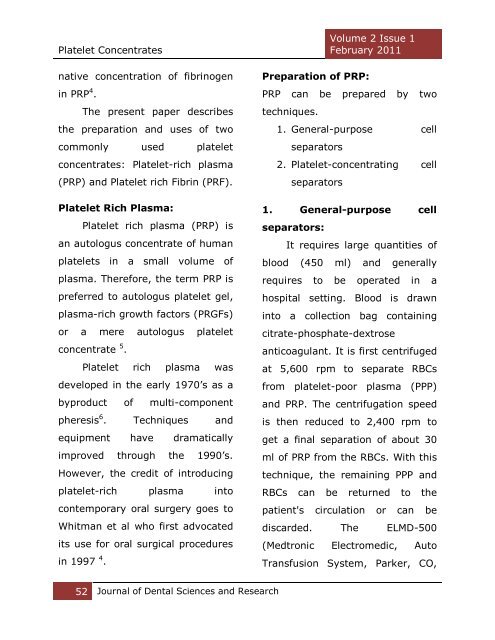Platelet Concentrates: A Promising Innovation In ... - Ssdctumkur.org
Platelet Concentrates: A Promising Innovation In ... - Ssdctumkur.org
Platelet Concentrates: A Promising Innovation In ... - Ssdctumkur.org
You also want an ePaper? Increase the reach of your titles
YUMPU automatically turns print PDFs into web optimized ePapers that Google loves.
<strong>Platelet</strong> <strong>Concentrates</strong><br />
native concentration of fibrinogen<br />
in PRP 4 .<br />
The present paper describes<br />
the preparation and uses of two<br />
commonly used platelet<br />
concentrates: <strong>Platelet</strong>-rich plasma<br />
(PRP) and <strong>Platelet</strong> rich Fibrin (PRF).<br />
<strong>Platelet</strong> Rich Plasma:<br />
<strong>Platelet</strong> rich plasma (PRP) is<br />
an autologus concentrate of human<br />
platelets in a small volume of<br />
plasma. Therefore, the term PRP is<br />
preferred to autologus platelet gel,<br />
plasma-rich growth factors (PRGFs)<br />
or a mere autologus platelet<br />
concentrate 5 .<br />
<strong>Platelet</strong> rich plasma was<br />
developed in the early 1970’s as a<br />
byproduct of multi-component<br />
pheresis 6 . Techniques and<br />
equipment have dramatically<br />
improved through the 1990’s.<br />
However, the credit of introducing<br />
platelet-rich plasma into<br />
contemporary oral surgery goes to<br />
Whitman et al who first advocated<br />
its use for oral surgical procedures<br />
in 1997 4 .<br />
Preparation of PRP:<br />
Volume 2 Issue 1<br />
February 2011<br />
PRP can be prepared by two<br />
techniques.<br />
1. General-purpose cell<br />
separators<br />
2. <strong>Platelet</strong>-concentrating cell<br />
separators<br />
1. General-purpose cell<br />
separators:<br />
It requires large quantities of<br />
blood (450 ml) and generally<br />
requires to be operated in a<br />
hospital setting. Blood is drawn<br />
into a collection bag containing<br />
citrate-phosphate-dextrose<br />
anticoagulant. It is first centrifuged<br />
at 5,600 rpm to separate RBCs<br />
from platelet-poor plasma (PPP)<br />
and PRP. The centrifugation speed<br />
is then reduced to 2,400 rpm to<br />
get a final separation of about 30<br />
ml of PRP from the RBCs. With this<br />
technique, the remaining PPP and<br />
RBCs can be returned to the<br />
patient's circulation or can be<br />
discarded. The ELMD-500<br />
(Medtronic Electromedic, Auto<br />
Transfusion System, Parker, CO,<br />
52 Journal of Dental Sciences and Research









